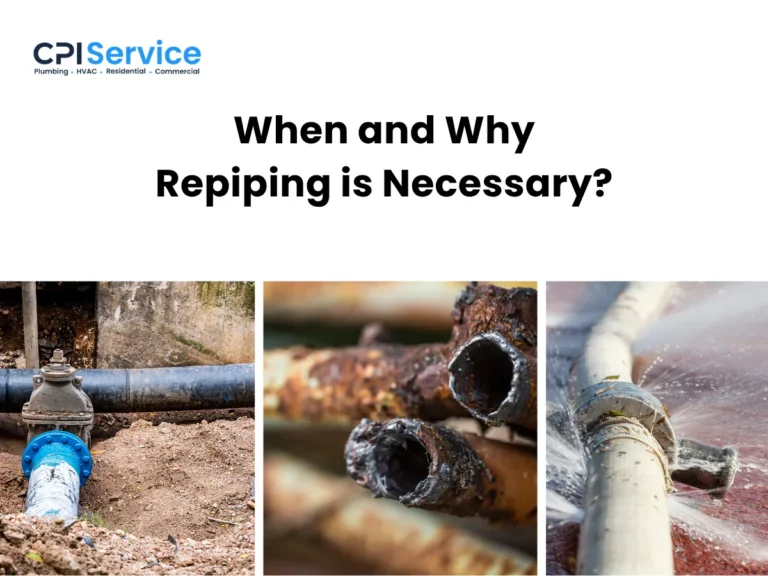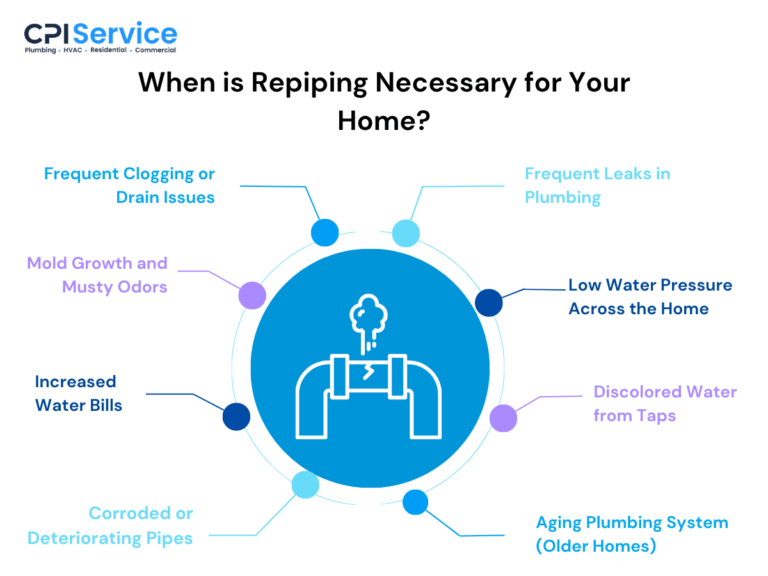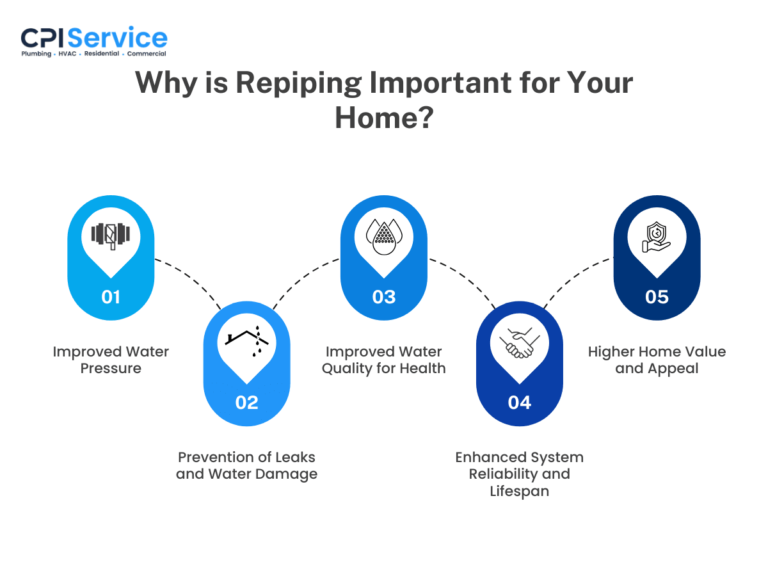When and Why Repiping is Necessary?
Repiping is necessary when plumbing systems are old, corroded, or leaking, and replacing them improves water quality, prevents damage, and increases long-term reliability. It becomes essential once signs like frequent leaks, discolored water, or low water pressure begin to impact daily use or pose health and structural risks.
Many of these warning signs begin subtly but often escalate if left unaddressed. Frequent leaks in the same areas suggest underlying pipe deterioration rather than isolated issues. Water that appears brown or rusty may signal internal corrosion, especially in older galvanized steel lines. Low water pressure across multiple fixtures is another red flag, typically caused by mineral buildup or narrowing of pipe interiors. These symptoms, especially in homes over 40 years old, indicate that the piping materials may be outdated and no longer dependable.

Repiping improves water quality, restores consistent pressure, and helps prevent future plumbing failures. For homeowners, this means lower repair costs, improved health protection, and increased property value. If your home shows two or more of these warning signs, it’s wise to schedule a full inspection with a licensed plumber. Addressing issues early not only prevents structural damage but also supports a healthier, more efficient living environment for the long term.
Table of Contents
When is Repiping Necessary for Your Home?

Repiping is necessary when you notice recurring leaks, low water pressure, rust-colored water, mold growth, or signs of pipe corrosion throughout your home. These issues often point to systemic plumbing failure, especially in older properties with outdated materials. If more than one of these symptoms appears, it is a strong indication that repairs alone may not be enough, and a full inspection is recommended.
Frequent Leaks in Plumbing
Frequent plumbing leaks, especially if they occur more than once every few months in the same areas, indicate pipe deterioration that often requires full repiping. These leaks typically result from pinhole corrosion, joint failure, or thinning pipe walls due to age or material fatigue. While a single leak may be isolated, repeated repairs point to a broader issue affecting the system. In older homes, particularly those with galvanized steel or copper pipes, internal corrosion gradually weakens the pipe structure. If you are patching leaks multiple times a year, replacing the entire piping system can prevent water damage and ongoing repair costs.
Low Water Pressure Across the Home
Low water pressure throughout the house, not just at one or two fixtures, is often caused by internal pipe blockage and may signal the need for repiping. This condition develops over time as rust, scale, and mineral deposits accumulate inside older galvanized steel pipes, narrowing their interior and restricting water flow. As a result, homeowners may notice slow-filling sinks, weak shower pressure, or inconsistent flow when multiple fixtures are in use. These symptoms are typically systemic rather than fixture-specific, making temporary fixes ineffective. In such cases, a full internal inspection is recommended to assess whether the entire system needs to be replaced.
Discolored Water from Taps
Brown, orange, or yellow water coming from taps is a clear sign of pipe corrosion and an urgent reason to consider repiping. This discoloration is usually caused by rust flaking off from the interior of steel or iron pipes and entering the water supply. In addition to affecting water clarity, this rust can leave stains on fixtures, sinks, and laundry while producing an unpleasant metallic taste. Over time, corroded pipes may also release sediment or heavy metals into your water, increasing health risks. Switching to PEX or copper piping eliminates these contaminants and ensures a clean, reliable water supply.
Aging Plumbing System (Older Homes)
Homes with plumbing systems older than 40 to 60 years often need repiping due to material degradation and outdated standards. Galvanized steel, lead, and polybutylene pipes, commonly used in homes built before the 1980s, are now known to corrode, leach metals, or become brittle over time. These materials can fail without a visible warning, and many no longer meet building codes. If your home has never had a plumbing upgrade and the original pipes are still in place, a proactive inspection is highly recommended to assess long-term safety and compliance.
Corroded or Deteriorating Pipes
Visible corrosion on exposed pipes, such as green or white crust, rust flakes, or soft spots, signals significant material breakdown that often requires repiping. These indicators are typically found in basements, crawlspaces, or utility areas where pipes are exposed to air and moisture. As corrosion progresses, pipe walls weaken, increasing the risk of unexpected leaks and water damage. Unlike newer piping materials like copper or PEX, older metal pipes degrade quickly under constant pressure and fluctuating temperatures. If corrosion is present in multiple locations, it likely affects hidden areas as well and should not be ignored.
Increased Water Bills
A sudden or steady rise in your water bills without a clear increase in usage often indicates hidden leaks caused by aging or compromised pipes. These leaks usually develop in concealed areas like behind walls, beneath floors, or under slab foundations, making them difficult to detect early. Even small cracks or pinhole leaks in older galvanized or copper pipes can waste hundreds of gallons each month, leading to a noticeable spike in utility costs. Often, no visible signs of moisture appear until structural damage is underway. If water use remains consistent but bills increase, a plumbing inspection can confirm pipe deterioration. Repiping can eliminate hidden losses, improve water efficiency, and restore stable monthly expenses.
Mold Growth and Musty Odors
Mold patches on walls, ceilings, or under cabinets, along with persistent musty odors, can be traced to hidden plumbing leaks that signal failing pipes. These leaks often originate from small cracks or corroded joints in aging pipes, allowing a continuous release of moisture into drywall, subfloors, or insulation. Over time, the trapped moisture creates ideal conditions for mold and mildew to thrive, particularly in low-ventilation areas like behind furniture or under sinks. Mold exposure can trigger respiratory issues, allergies, and long-term health concerns, especially for sensitive individuals. If mold appears in unusual spots without a visible water source, deteriorating plumbing is a likely cause. In such cases, repiping is often the only lasting solution to stop the leak and prevent further contamination.
Frequent Clogging or Drain Issues
Regular clogging in sinks, tubs, or toilets, despite repeated clearing, can indicate internal pipe damage or improper slope, both of which may require repiping. Over time, older pipes develop rough inner surfaces due to mineral buildup and corrosion, which trap debris and cause persistent blockages. In some homes, shifting foundations or soil movement can misalign drainpipes, further restricting flow. These issues often affect multiple drains at once and may present as gurgling sounds or slow drainage across the system. When routine cleaning no longer resolves the problem, repiping may be a more effective solution than continued spot repairs or drain cleaning, offering a more permanent fix.
Why is Repiping Important for Your Home?

Repiping is essential for improving water pressure, preventing leaks and water damage, enhancing water quality, increasing system reliability, and boosting home value. These benefits directly address the risks associated with aging or deteriorating pipes, such as health concerns, rising utility bills, and frequent plumbing failures. Upgrading your plumbing system with modern materials, such as PEX (cross-linked polyethylene), copper, or CPVC (chlorinated polyvinyl chloride), ensures consistent performance, long-term safety, and greater confidence in your home’s infrastructure.
Improved Water Pressure
One of the most immediate benefits of repiping is the return of consistent, strong water pressure throughout the home. Aging pipes often develop scale, rust, or mineral buildup along their inner walls, which restricts flow and causes noticeable pressure drops at showers, faucets, and appliances. Galvanized steel pipes are especially susceptible to internal constriction over time.
By replacing these clogged or corroded pipes with modern materials like PEX or copper, the plumbing system regains its full internal diameter, allowing water to move freely and evenly. This results in improved pressure across all fixtures, more efficient water use, and better overall performance in daily household tasks.
Prevention of Leaks and Water Damage
Repiping is a critical step in stopping recurring leaks and preventing hidden water damage before it becomes costly. As pipes age, they weaken at joints and bends, making them vulnerable to small cracks or pinhole leaks that often go unnoticed until visible damage appears. Moisture from these leaks can saturate insulation, damage drywall, and promote rot within structural materials.
Installing a new, properly sealed pipe system eliminates these weak points. New piping significantly reduces the risk of water intrusion, providing long-term protection against mold growth and structural decay. This preventive measure helps homeowners avoid emergency repairs and costly renovations caused by neglected leaks.
Improved Water Quality for Health
Repiping delivers cleaner, safer water by removing old, contaminant-prone materials from your plumbing system. Over time, pipes made of galvanized steel, iron, or lead can release rust particles, sediment, or even toxic metals into your water supply. These contaminants affect water clarity, taste, and pose potential health risks.
Replacing them with PEX or copper ensures a clean, corrosion-resistant interior that maintains water purity over time. This upgrade minimizes exposure to harmful substances and eliminates bacterial buildup caused by decaying pipe interiors. For households with children, elderly residents, or anyone with health sensitivities, repiping is a protective investment.
Enhanced System Reliability and Lifespan
Modernizing your home’s plumbing through repiping increases long-term system reliability and reduces the frequency of disruptive failures. Older pipes are more likely to burst, freeze, or fail under pressure due to thinning walls and weakened joints. These failures often happen without warning and lead to expensive emergency interventions.
New piping systems, especially those made from flexible, durable PEX or corrosion-resistant copper, are engineered to last 40 to 50 years or more. This long lifespan, combined with reduced vulnerability to pressure or temperature changes, provides homeowners with peace of mind and stable plumbing performance for decades.
Higher Home Value and Appeal
A repiped plumbing system significantly increases a home’s market appeal and value by replacing outdated infrastructure with code-compliant, modern materials. Older systems raise concerns for potential buyers and home inspectors, particularly when made from galvanized steel, lead, or polybutylene. These materials are often flagged during inspections and may delay or complicate real estate transactions.
Repiping eliminates those concerns and signals to buyers that the home has been properly maintained and upgraded. It can lead to faster closings, higher offers, and reduced insurance risk. For sellers, a new plumbing system becomes a strong resale asset, offering tangible value during negotiations.
What Are the Issues Related to Repiping?
Repiping involves several challenges, including high upfront costs, short-term disruption during installation, and potential damage to walls, ceilings, or floors. While the long-term benefits are well worth it, these issues can make the decision more difficult for homeowners, especially when budgeting or planning around daily routines.
Working with a licensed and experienced contractor helps reduce the impact. A clear project timeline, protective measures, and thorough restoration are essential to managing the process smoothly. Professional plumbing companies follow a streamlined repiping process that limits disruption, protects finished areas, and includes complete post-installation restoration to return the home to its original condition.
High Upfront Costs
The financial cost of repiping is often the first and most significant concern for homeowners, with total expenses reaching up to $15,000. Factors such as home size, pipe length, and choice between copper or PEX affect the final price. While the initial investment may seem high, it prevents future spending on repeated leak repairs and hidden water damage. To make the project more affordable, homeowners can request itemized quotes, explore alternative materials, and ask contractors about financing options or phased work plans.
Disruption During Installation
The installation phase of repiping often causes noticeable disruption to daily routines, particularly when water access is limited and construction work is underway. Plumbers usually need to cut into walls, ceilings, or floors to reach existing pipe networks, which can generate dust, noise, and temporary inconvenience. However, experienced contractors typically manage the process in zones, restore water access in phases, and use containment measures to reduce impact. With good scheduling and clear communication, most homes remain livable throughout the upgrade.
Potential Home Damage
Repiping can cause visible damage to finished surfaces, as contractors must create access points to remove old pipes and install new ones. Depending on the layout of the plumbing system, areas such as drywall, tile, or baseboards may need to be cut or temporarily removed. While this disruption is part of the process, it does not have to result in lasting damage. Most licensed plumbers include full restoration, such as patching, painting, and surface repair, as part of the project scope. By confirming these restoration details in advance, homeowners can feel confident that their living space will be returned to its original condition without compromise.
How Much Does Repiping Cost?
Repiping cost typically ranges from $1,500 to $15,000, depending on factors such as home size, number of bathrooms, pipe material, and regional labor rates. Larger homes with complex layouts or multiple stories usually fall on the higher end of the scale. Material choice also plays a significant role, as copper piping is more expensive than PEX but may offer added durability in some situations.
To make an informed decision, homeowners should compare detailed estimates from at least two or three licensed plumbing contractors. Each quote should outline material costs, labor, access, and surface restoration. This approach ensures pricing transparency and helps you choose the most qualified provider for long-term value and reliability.
Cost to Repipe a House
The cost to repipe a house typically ranges from $1,500 to $15,000, depending on key factors such as the total square footage, number of bathrooms, plumbing layout, and type of piping material selected. Copper piping is generally more expensive due to its strength and long-term durability, while PEX is a cost-effective option that is easier and faster to install, making it a popular choice for many homeowners.
For a standard two-bathroom home, repiping with PEX typically costs between $6,000 and $7,500. Larger homes or properties with complex access requirements may reach the higher end of the price range. To budget effectively, it is best to consult local professionals who can provide detailed, customized estimates based on your home’s specific layout and conditions.
Get Your Free Repiping Estimate Today!
Ready to improve your home’s plumbing and secure long-term savings? Contact our expert team at CPI Services for a free, no-obligation repiping estimate. Our specialists will assess your home, provide transparent pricing, and ensure your plumbing system is in top condition.
Schedule your consultation now
Alex Hamilton
Alex Hamilton is the owner of CPI Service, a trusted provider of plumbing and HVAC solutions. With over 35+ years of hands-on experience in the industry, He brings deep technical expertise and a proven track record in delivering reliable installation, maintenance, and repair services. His leadership ensures that CPI Service consistently upholds the highest standards of quality, safety, and customer satisfaction.
